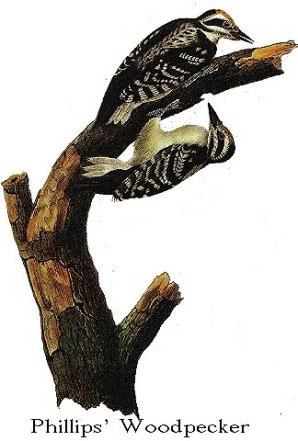
| Family XVI. PICINAE. WOODPECKERS. GENUS I. PICUS, Linn. WOODPECKER. |
Next >> |

Family |
PHILLIPS' WOODPECKER. [Hairy Woodpecker (see also Canadian Woodpecker, Maria's Woodpecker, Harris' Woodpecker, Hairy Woodpecker, and Audubon's Woodpecker).] |
| Genus | PICUS PHILLIPSII, Aud. [Picoides villosus.] |
The only specimen of this beautiful Woodpecker that I have seen, an adult
male, was sent to me by my friend Mr. NUTTALL, who procured it in the State of
Massachusetts. Nothing is known as to its habits. In naming it after my friend
BENJAMIN PHILLIPS, Esq., F.R.S., I have the pleasure of testifying my esteem and
gratitude towards one whose kindness and generosity has often been experienced
by me and every member of my family. The beauty of this bird has induced me to
give two figures of it, by which its form and markings may be better seen.
PHILLIPS' WOODPECKER, Picus Phillipsii, Aud. Orn. Biog., vol. v. p. 186.
Male, 10 1/2; wing, 5.
Massachusetts. Very rare.
Adult Male.
Bill about the length of the head, straight, strong, angular, compressed
toward the tip, which is pointed. Upper mandible with the dorsal line straight,
the ridge very narrow, the sides sloping and flat, the lateral angle half-way
between the ridge and the edge at the base, and running out upon the latter
about two-thirds of its length, the edges sharp and overlapping, the tip
acuminate. Lower mandible with the angle short and rather wide, the dorsal line
straight, the ridge narrow, the sides convex toward the edges, which are sharp
and inflected, the tip acuminate. Nostrils oblong, basal, concealed by the
feathers, and placed near the margin.
Head large, ovate; neck rather short; body full. Feet very short; tarsus
short, compressed, feathered anteriorly more than one-third down, scutellate in
the rest of its extent, and with a series of large scales behind; toes four;
first small, but stout; third and fourth about the same length; second and third
united at the base; all scutellate above. Claws large, much curved, compressed,
laterally grooved, very acute.
Plumage very soft, full, and blended. A tuft of reversed stiffish feathers
on each side of the base of the upper mandible, concealing the nostrils; the
feathers in the angle of the lower mandible also stiffish, and directed
forwards. Wings rather long; the first quill very small, the second
five-twelfths of an inch shorter than the third, the fourth longer than the
latter by one-twelfth, but scarcely exceeding the fifth; secondaries broad and
rounded. Tail of moderate length, cuneate, of twelve feathers, of which the
lateral are only an inch and a quarter long and rounded, the next an inch and
two-twelfths shorter than the middle, the rest worn and slit at the tip.
Bill dusky, its margins pale at the base. Iris red. Feet bluish-grey,
claws dusky. The tufts of feathers covering the nostrils are yellowish-white;
the fore part of the head to a little beyond the top orange-yellow; the occiput
and hind neck glossy black; over each eye is a band of white passing to behind
the auriculars; a black band from above the angle of the mouth to the eye, and
behind it, including the auriculars; below this a white band from the angle of
the mouth joining that over the eye; and lastly, a narrower black band from the
lower mandible. The upper parts are black, tinged with brown behind; the
feathers along the middle of the back tipped with white; some of the
wing-coverts are tipped with white, and the quills spotted with the same, there
being on the four largest primaries seven spots on the outer, and five on the
inner web. The four middle tail-feathers are glossy black, the rest black
towards the base, that colour gradually diminishing so that the outermost is
almost entirely white. The lower parts are white.
Length to end of tail 10 1/2 inches; bill along the ridge 1 3/12, along the
edge of lower mandible 1 5/12; wing from flexure 5; tail 3 8/12; tarsus
(9 1/2)/12; inner toe (3 1/2)/12, its claw 4/12; second toe 6/12, its claw
(5 1 2)/12; third toe 8/12, its claw 6/12; fourth toe 10/12, its claw 6/12.
This species is about the same size as P. canadensis, which it also
resembles in colour, but is distinguished by the yellow patch on the head, and
its thicker and more pointed bill.
| Next >> |